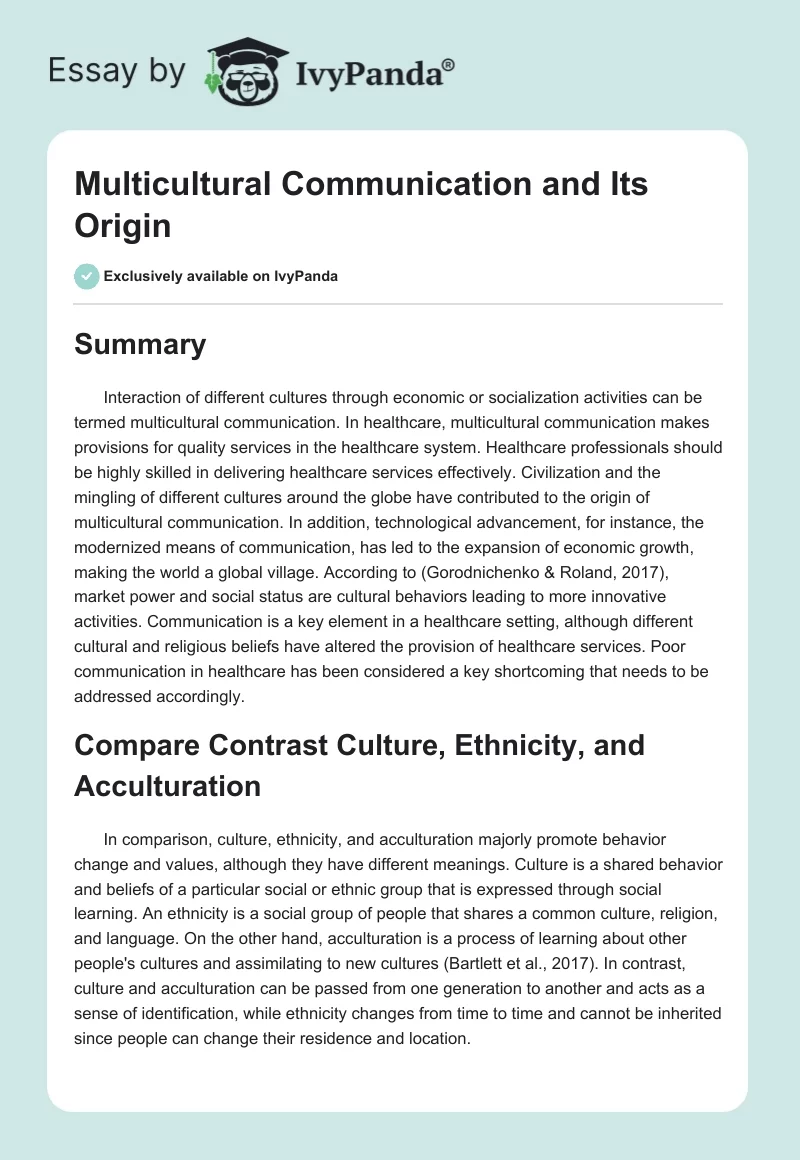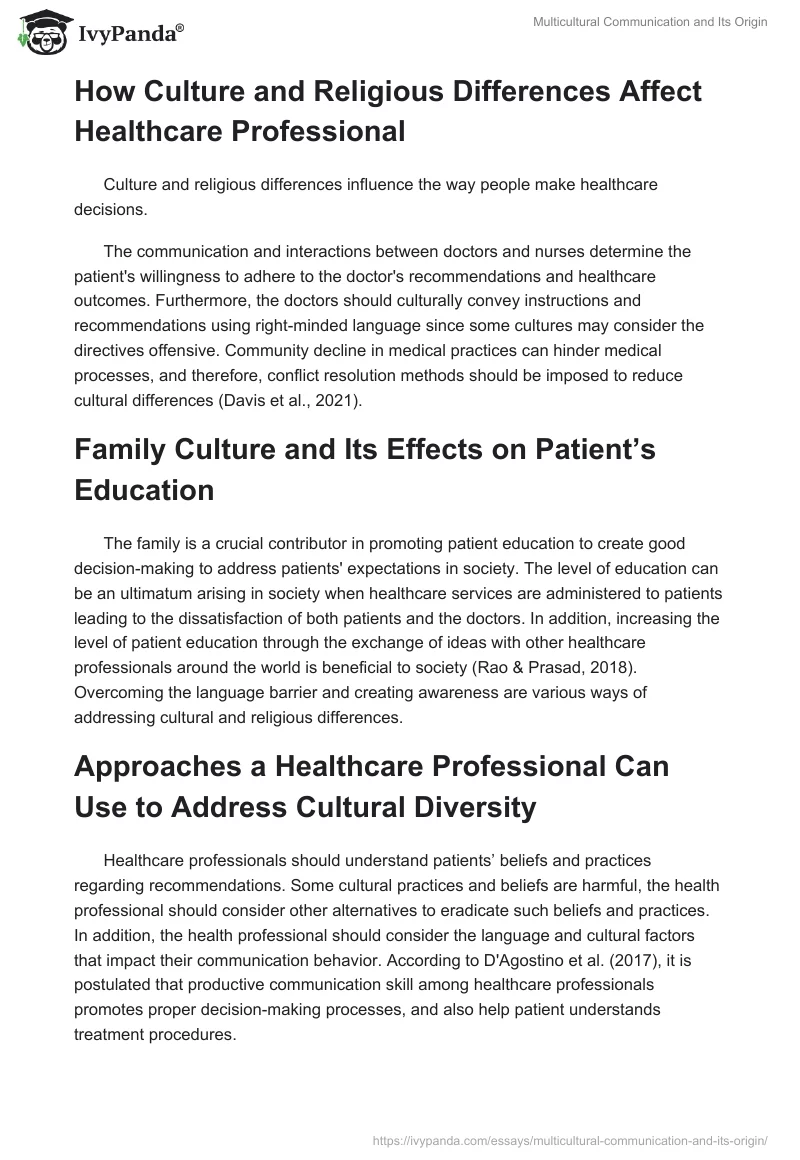Summary
Interaction of different cultures through economic or socialization activities can be termed multicultural communication. In healthcare, multicultural communication makes provisions for quality services in the healthcare system. Healthcare professionals should be highly skilled in delivering healthcare services effectively. Civilization and the mingling of different cultures around the globe have contributed to the origin of multicultural communication. In addition, technological advancement, for instance, the modernized means of communication, has led to the expansion of economic growth, making the world a global village. According to (Gorodnichenko & Roland, 2017), market power and social status are cultural behaviors leading to more innovative activities. Communication is a key element in a healthcare setting, although different cultural and religious beliefs have altered the provision of healthcare services. Poor communication in healthcare has been considered a key shortcoming that needs to be addressed accordingly.
Compare Contrast Culture, Ethnicity, and Acculturation
In comparison, culture, ethnicity, and acculturation majorly promote behavior change and values, although they have different meanings. Culture is a shared behavior and beliefs of a particular social or ethnic group that is expressed through social learning. An ethnicity is a social group of people that shares a common culture, religion, and language. On the other hand, acculturation is a process of learning about other people’s cultures and assimilating to new cultures (Bartlett et al., 2017). In contrast, culture and acculturation can be passed from one generation to another and acts as a sense of identification, while ethnicity changes from time to time and cannot be inherited since people can change their residence and location.
How Culture and Religious Differences Affect Healthcare Professional
Culture and religious differences influence the way people make healthcare decisions.
The communication and interactions between doctors and nurses determine the patient’s willingness to adhere to the doctor’s recommendations and healthcare outcomes. Furthermore, the doctors should culturally convey instructions and recommendations using right-minded language since some cultures may consider the directives offensive. Community decline in medical practices can hinder medical processes, and therefore, conflict resolution methods should be imposed to reduce cultural differences (Davis et al., 2021).
Family Culture and Its Effects on Patient’s Education
The family is a crucial contributor in promoting patient education to create good decision-making to address patients’ expectations in society. The level of education can be an ultimatum arising in society when healthcare services are administered to patients leading to the dissatisfaction of both patients and the doctors. In addition, increasing the level of patient education through the exchange of ideas with other healthcare professionals around the world is beneficial to society (Rao & Prasad, 2018). Overcoming the language barrier and creating awareness are various ways of addressing cultural and religious differences.
Approaches a Healthcare Professional Can Use to Address Cultural Diversity
Healthcare professionals should understand patients’ beliefs and practices regarding recommendations. Some cultural practices and beliefs are harmful, the health professional should consider other alternatives to eradicate such beliefs and practices. In addition, the health professional should consider the language and cultural factors that impact their communication behavior. According to D’Agostino et al. (2017), it is postulated that productive communication skill among healthcare professionals promotes proper decision-making processes, and also help patient understands treatment procedures.
Types of Illiteracy
There is important for healthcare professionals to use simple medical terms that the patients can understand. Some patients have learning disabilities which make their ability to learn slowly due to illiteracy. One implication of illiteracy and learning disability is difficulty in analyzing medical instructions. There are various types of illiteracy including functional, cultural, civil, and literal illiteracy. According to (Beaulieu et al., 2017), a lack of confidence in health care professional contributes to stigmatization through the clinical relationship between the patient and the doctor, mainly when accompanied by negative attitudes.
Discussion about Illiteracy as a Disability
Factors such as poverty, learning disabilities, and low education can attribute to the high levels of illiteracy. The creation of programs such as training the patients on how to read and interpret information on their own can be an achievement in their lives (McCalman et al., 2017). Brain injury can lead to learning disability hence interfering with the patient’s daily routine practice. The health professional exterminates the assumption that every patient is capable of following medical instructions perfectly. Having access to reading materials such as newspapers and magazines helps them understand the importance of their health care issues.
Examples of Myths about Illiteracy
Myths have become common, and therefore the most trustworthy means to educate patients is required. Although illiteracy and economic status are related, illiteracy occurs to many different types of people and is not limited to the educational or socio-economic base. Also, it is believed that patients with reading disabilities will let their health professionals know. Patients can hide their illiteracy from health care professionals for fear of being regarded as unintelligent. Patients who do not speak the local can be disadvantaged when accessing healthcare services compared to local speakers (Floyd & Sakellariou, 2017).
How to Assess Literacy Skills and Evaluate Written Material for Readability
Assessing the readability materials used by particular patients ensures quality information is formulated. Various adapted formulas and tools such as Simple Measure of Gobbledygook (SMOG) are employed to evaluate the level of readability in patients. Experiencing sensitivity toward cultural differences and perspectives of people from other cultures that establishes effective communication (Henderson et al., 2016). Further, health care professionals can use non-verbal communication skills such as body movements, eye contact, touch, and facial expressions to communicate with patients.
Ways a Healthcare Professional May Establish Effective Communication
Non-verbal communication helps the professional to understand the patient’s needs and raise the alarm urgently. Improving non-verbal communication raises awareness of patients’ communication styles in society (Li et al., 2017). Also, communicating empathy can be paramount in patient education through expressing the patient’s feelings to the health care professional. Effective communication among doctors improves their knowledge and skills while increasing medical satisfaction perceived by the patient (Hemberg & Vilander 2017).
Ways a Health Professional Uses to Help a Patient Remember Instructions
Various ways that a health care professional use in helping patients remember instructions include writing the instruction down. The health care professional can also use diagrams and pictures in patient education to help them remember instructions quickly. When conducting patient teaching, a healthcare professional needs to use simply accurate medical terms. Finally, the information given should be disintegrated to make the patient detect crucial information. Repetition can facilitate their ability to synthesize what is essential and remember the information given. Health care systems are investing in various ways to improve the quality of information for the patients to remember (Federman et al., 2017).
References
Bartlett, L., Mendenhall, M., & Ghaffar-Kucher, A. (2017). Culture in acculturation: Refugee youth’s schooling experiences in international schools in New York City. International Journal of Intercultural Relations, 60(4) 109-119.
Beaulieu, T., Patten, S., Knaak, S., Weinerman, R., Campbell, H., & Lauria-Horner, B. (2017). Impact of skill-based approaches in reducing stigma in primary care physicians: Results from a bouble-blind, parallel-cluster, randomized controlled trial. Canadian Journal of Psychiatry, 62 (5), 327–355.
D’Agostino, T. A., Atkinson, T. M., Latella, L. E., Rodgers, M., Morrissey, D., DeR-osa, A. P., & Parker, P. A. (2017). Promoting patient participation in healthcare interactions through communication skills training: A systemic review. Patient Education and Counselling, 100(7), 1247-1257.
Davis, E. B., Plante, T. G., Grey, M. J., Kim, C. L., Freeman-Coppadge, D., Lefevor, G. T., Paulez, J. A., Giwa, S., Lasser, J., Stratton, S. P., Deneke, E., & Glowiak, K. J. (2021). The role of civility and cultural humility in navigating controversial areas in psychology. Spirituality in Clinical Practice, 8(2), 79–97. Web.
Federman, A., Sarzynski, E., Brach, C., Francaviglia, P., Jacques, J., Jandorf, L…. & Kannry, J. (2018). Challenges optimizing the after-visit summary. International Journal of Medical Informatics, 120, 14-19. Web.
Floyd, A., & Sakellariou, D. (2017). Healthcare access for refugee women with limited literacy: layers of disadvantage. International Journal for Equity in Health, 16(1), 1-10.
Gorodnichenko, Y., & Roland, G. (2017). Culture, institutions, and the wealth of nations. Review of Economics and Statistics, 99(3), 402-416. Web.
Hemberg, J.A.V., & Vilander, S. (2017). Cultural and communicative competence in the caring relationship with patients from another culture. Scandinavian Journal of Caring Sciences 31(4), 822-829.
Henderson, S., Barker, M., & Mark, A. (2016). Strategies used by nurses, academics, and students to overcome intercultural communication challenges. Nurse Education in Practice, 16(1), 71-78. Web.
Li, C., Son, N., Abdulkerim, B. A., Jordan, C. A., & Son, C. G. E. (2017). Overcoming communication barriers to healthcare for culturally and linguistically diverse patients. North American Journal of Medicine and Science, 10(3), 103-109.
McCalman, J., Jongen, C., & Bainbridge, R. (2017). Organizational systems’ approaches to improving cultural competence in healthcare: A systematic scoping review of the literature. International Journal for Equity in Health, 16(1), 1-19. Web.
Rao, B., & Prasad, R. (2018). Principles of family medicine practice: Lessons gleaned over a lifetime in practice. Journal of Family Medicine and Primary Care, 7(2), 303-308. Web.


